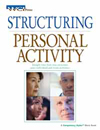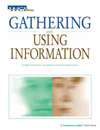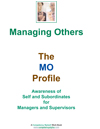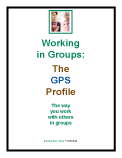| Title |
Format |
Summary |
|
Intended Audience |
| E-Learning and Work Book Based Skill Development Programs |
| Becoming A FeedBack Wizard |
E-Learning Program |
An e-learning program that uses short animated video clips and structured active exercises to allow working individuals to acquire the skills necessary to give others behavioral feedback.
The ability to give effective behavioral feedback is a core interpersonal competency needed for personal professional development and the coaching of direct reports. Few training programs exist which break this competency down into a series of manageable component skills. Everyone seems to assume that this competency just comes naturally with the movement up the career ladder to the "manager" level.
When professional professional programs do address feedback, they usually present it as a simple skill, which individuals can acquire through reading or attendance at a largely lecture based program. Few of these programs deliver more to individuals more than facts (know that) about giving behavioral feedback. As a result, feedback behavior back-on-the-job seldom changes as a result of attendance at such programs.
Giving behavioral feedback under all conditions, including ones involving stress between the two interacting individuals, is a complex competency that integrates 5 component skills. This program breaks giving behavioral feedback down into these 5 skills. It guides individuals through the steps needed to acquire each one. It concludes with a number of practice scenarios that integrate these component skills into a single competency.
The program uses short animated video clips to:
- show e-learners models of effective and ineffective feedback behaviors,
- set problem cases and short scenarios to which participants respond in order to develop their personal skills in the component behaviors.
|
|
Business Professionals |
| Becoming An Interview Wizard: An Introduction |
E-Learning Program |
Interviewing is an invaluable competency, not just for journalists and investigators, but also for working professionals and managers. The need to conduct a "conversation with purpose" for the purpose of getting needed information comes up each and every day in a working professional's life.
This voice over presentation introduces an e-learner to the basic ideas and component skills that make up the interviewing competency.
|
|
|
Business Professionals |
| Becoming An Interview Wizard: The Skills |
E-Learning Program |
This e-learning program dives into more depth about what it takes for you to be an effective interviewer. After completing it, you will understand:
- what interviewing is,
- what interviewing is not,
- the various business, commercial, journalistic, and investigative contexts in which interviewing is used,
- the 15 component skills used by interviewers;
- which of the 15 competent skills are used in which interviewing contexts,
- and the nature of each of the 15 component skills.
These "know that" introduction is followed by 10 "know how" e-learning sessions. Each one focuses on one of the ten component skills that are used in all interviewing situations. These ten units all use short video clips to model skilled and unskilled versions of the skills. Video clips are also used to provide learning game questions and skill development drills.
|
|
Business Professionals |
Making Decisions

|
Competency Styles® Skill Development Workbook (Amazon.com)
|
The Making Decisions work book provides you with insight into how you behave when you make decisions by yourself and with others. After you have completed the workbook, you will have insight into your own behavior patterns, the patterns of others, and the way you interact with them in the following five behavior areas.
1. The criteria you use to make a decision when you make a decision by yourself,
2. The standards you follow when working with others to make a decision,
3. The way in which you deal with differences of opinions when making decisions with others,
4. What you do after a decision has been made in a group,
5. The way you behave personally after a decision has been finalized.
|
|
Business Professionals |
Interacting With Others
 |
Competency Styles® Skill Development Workbook
(WCI Press)
Available from Roelf directly
Contact Roelf via email or get 5 packs from Amazon.com
|
The Interacting with Others work book provides you with insight into how you behave when you interact with others in one-on-one and in team situations. After you have completed the workbook, you will have insight into your own behavior patterns, the patterns of others, and the way you interact with them in the following five behavior areas.
1. The way you initiate contact and communicate with others,
2. The kind and level of energy you bring to your interactions with others,
3. How you express your ideas, emotions, interests, and feelings to others,
4. How you interact with others when in group situations,
5. The number of people with whom you maintain contact and stay involved.
|
|
Business Professionals |
Structuring Personal Activity
 |
Competency Styles® Skill Development Workbook (Amazon.com)
|
Structuring Personal Activity provides you with insight into how you behave as you structure your own work activity, and the work activities that you do with others. After you have completed the workbook, you will have insight into your own behavior patterns, the patterns of others, and the way you interact with them in the following five behavior areas.
1. The way you organize your personal work and your personal work environment,
2. The degree of structure you want in your daily activities,
3. The way you structure the smaller tasks and activities required to complete your larger projects,
4. How to be most creative when you have to meet deadlines,
5. The ways in which you structure your free time.
|
|
Business Professionals |
Gathering and Using Information
 |
Competency Styles® Skill Development Workbook (Amazon.com)
|
Gathering and Using Information provides you with insight into how you behave as you process the information that you deal with each day at work. After you have completed the workbook, you will have insight into your own behavior patterns, the patterns of others, and the way you interact with them in the following five behavior areas.
1. The kind of things to which you pay attention in your perceptions,
2. How you use your perceptions and ideas to develop something new,
3. How you apply your perceptions and ideas to problems and issues,
4. How you determine what is true and construct new knowledge, 5. The social context in which you use your perceptions and ideas.
|
|
Business Professionals |
Relating Styles

|
Competency Styles® Skill Development Workbook (Amazon.com)
|
Relating Styles is a Competency Styles® workbook that can be used by the two people in a working or life partnership. It makes no assumptions about the health or state of the relationship. It does provide both partners with insight into their personal communication and decision making behavior patterns used in the relationship. It also provides both partners insight into how their behavior patterns interact with those of the other partner.
|
|
Business Professionals |
Development Styles
 |
Competency Styles® Skill Development Workbook (WCI Press)
Available from Roelf directly
Contact Roelf to get a copy
|
Development is a Competency Styles® workbook that gives you insight into your preferred personal development activities. It helps you clarify which parts of professional development or technical training programs work best for you. It also gives you a framework for understanding your own preferred development activities and those of your subordinates if you are a manager, or your co-workers if you work in teams.
|
|
Business Professionals |
Managing Others
 |
Competency Styles® Skill Development Workbook (WCI Press)
Available from Roelf directly
Contact Roelf to get a copy. |
Each of your subordinates is a different person. You need to assign them work, help they develop their skills and abilities, manage their performance, provide feedback on a regular basis and intervene when their performance or poor interaction with others requires it.
Most managers have very little insight into how to flex their personal behavior to maximize the effectiveness of their interaction with each of their subordinates. . We learn to manage others implicitly, during our careers, from watching other managers, and being managed ourselves. As a result, we are often unclear about the best way to work with a specific subordinate, especially when we find that some of the things that we do that work with one person does not work well with others.
"Managing Others: The MO Profile" addresses this issue. The work book gives each of us insight into the two most important behavior patterns we need to be an effective manager.
|
|
Business Professionals |
The GPS Profile: Working In Groups

|
Competency Styles® Skill Development Workbook
(WCI Press)
Available from Roelf directly
Contact Roelf to get a copy. |
If you are like most people who work in an business environment, at least part of your day is spent working with others, either in meetings or sitting side by side with another person.
Most of us who do so have very little insight into how to optimize that work. We learn to work with others as an implicit part of growing up - starting in grade school, and going on from there. As a result, we are often unclear about the best way to work with other people, especially when we find that some of the things that we do that work with some people do not work well with others.
"Working in Groups: The GPS Profile" addresses this issue. The work book gives each of us insight into the two most important behavior patterns we take with us into all of interaction with others in groups:
- the ways in which we are verbally active (or inactive) - our verbal participation style,
- and the way we make decisions in conjunction with others - our decision making participation style.
|
|
Business Professionals |








